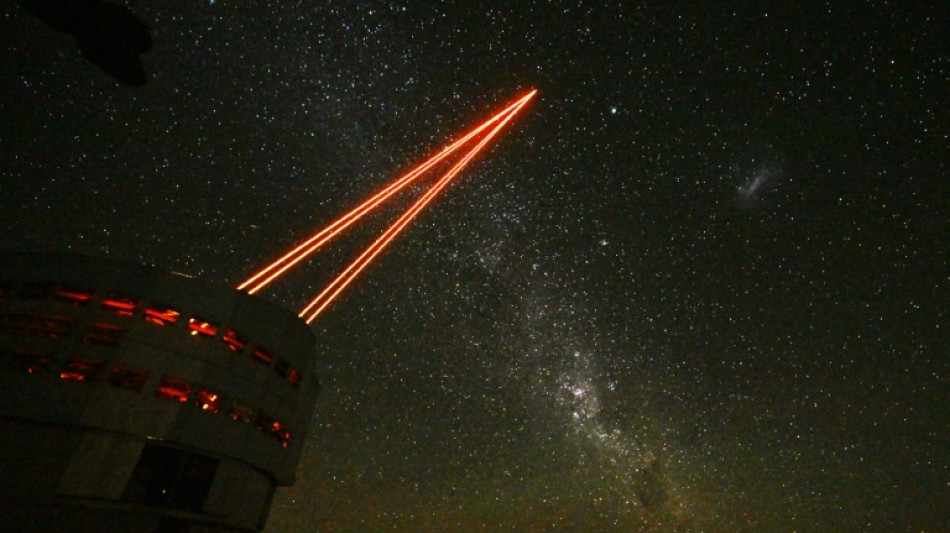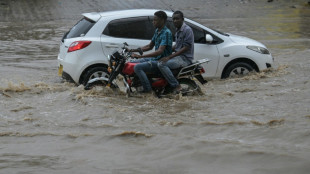
-
 Kenya's economy faces climate change risks: World Bank
Kenya's economy faces climate change risks: World Bank
-
World stocks mostly slide, consolidating Fed-fuelled gains

-
 Crypto firm Tether bids for Juventus, is quickly rebuffed
Crypto firm Tether bids for Juventus, is quickly rebuffed
-
UK's king shares 'good news' that cancer treatment will be reduced in 2026

-
 Can Venezuela survive US targeting its oil tankers?
Can Venezuela survive US targeting its oil tankers?
-
Salah admired from afar in his Egypt home village as club tensions swirl

-
 World stocks retrench, consolidating Fed-fuelled gains
World stocks retrench, consolidating Fed-fuelled gains
-
Iran frees child bride sentenced to death over husband's killing: activists

-
 World stocks consolidate Fed-fuelled gains
World stocks consolidate Fed-fuelled gains
-
France updates net-zero plan, with fossil fuel phaseout

-
 Stocks rally in wake of Fed rate cut
Stocks rally in wake of Fed rate cut
-
EU agrees recycled plastic targets for cars

-
 British porn star to be deported from Bali after small fine
British porn star to be deported from Bali after small fine
-
British porn star fined, faces imminent Bali deportation

-
 Spain opens doors to descendants of Franco-era exiles
Spain opens doors to descendants of Franco-era exiles
-
Indonesia floods were 'extinction level' for rare orangutans

-
 Thai teacher finds 'peace amidst chaos' painting bunker murals
Thai teacher finds 'peace amidst chaos' painting bunker murals
-
Japan bear victim's watch shows last movements

-
 South Korea exam chief quits over complaints of too-hard tests
South Korea exam chief quits over complaints of too-hard tests
-
French indie 'Clair Obscur' dominates Game Awards

-
 South Korea exam chief resigns after tests dubbed too hard
South Korea exam chief resigns after tests dubbed too hard
-
Asian markets track Wall St record after Fed cut

-
 Laughing about science more important than ever: Ig Nobel founder
Laughing about science more important than ever: Ig Nobel founder
-
Vaccines do not cause autism: WHO

-
 Crypto mogul Do Kwon sentenced to 15 years for fraud: US media
Crypto mogul Do Kwon sentenced to 15 years for fraud: US media
-
'In her prime': Rare blooming of palm trees in Rio

-
 Make your own Mickey Mouse clip - Disney embraces AI
Make your own Mickey Mouse clip - Disney embraces AI
-
OpenAI beefs up GPT models in AI race with Google

-
 Dark, wet, choppy: Machado's secret sea escape from Venezuela
Dark, wet, choppy: Machado's secret sea escape from Venezuela
-
Cyclone causes blackout, flight chaos in Brazil's Sao Paulo

-
 2024 Eurovision winner Nemo returns trophy over Israel's participation
2024 Eurovision winner Nemo returns trophy over Israel's participation
-
US bringing seized tanker to port, as Venezuela war threats build

-
 Make your own AI Mickey Mouse - Disney embraces new tech
Make your own AI Mickey Mouse - Disney embraces new tech
-
Time magazine names 'Architects of AI' as Person of the Year

-
 Floodworks on Athens 'oasis' a tough sell among locals
Floodworks on Athens 'oasis' a tough sell among locals
-
OpenAI, Disney to let fans create AI videos in landmark deal

-
 German growth forecasts slashed, Merz under pressure
German growth forecasts slashed, Merz under pressure
-
Thyssenkrupp pauses steel production at two sites citing Asian pressure

-
 ECB proposes simplifying rules for banks
ECB proposes simplifying rules for banks
-
Stocks mixed as US rate cut offset by Fed outlook, Oracle earnings

-
 Desert dunes beckon for Afghanistan's 4x4 fans
Desert dunes beckon for Afghanistan's 4x4 fans
-
Breakout star: teenage B-girl on mission to show China is cool

-
 Chocolate prices high before Christmas despite cocoa fall
Chocolate prices high before Christmas despite cocoa fall
-
Austria set to vote on headscarf ban in schools

-
 Asian traders cheer US rate cut but gains tempered by outlook
Asian traders cheer US rate cut but gains tempered by outlook
-
AI's $400 bn problem: Are chips getting old too fast?

-
 Oracle shares dive as revenue misses forecasts
Oracle shares dive as revenue misses forecasts
-
US stocks rise, dollar retreats as Fed tone less hawkish than feared

-
 Divided US Fed makes third straight rate cut, signals higher bar ahead
Divided US Fed makes third straight rate cut, signals higher bar ahead
-
Machado to come out of hiding after missing Nobel ceremony


Could a climate megaproject cloud Chile's unparalleled views of universe?
As night falls on the Atacama desert in northern Chile four giant telescopes turn their gaze towards the star-strewn heavens.
The driest place on Earth is the best place to observe the universe, with darkness offering dazzling spectacles of cosmic wonder.
The area is home to the Paranal Observatory, which houses the European Southern Observatory's Very Large Telescope, used by astronomers to search the Milky Way with "unparalleled clarity," according to Spanish astrophysicist Itziar de Gregorio.
Perched at 2,635 meters (8,645 feet) above sea level, and located dozens of kilometers (miles) from the nearest town of Antofagasta, Paranal's unique atmospheric conditions make it one of the most productive observatories in the world.
The Very Large Telescope -- made up of four individual telescopes -- produced the first ever image of an exoplanet (a planet outside our solar system) in 2004.
But a huge green energy project, part of Chile's plans to become carbon neutral, risks clouding the view, scientists say.
Latin America's fifth-largest economy aims to phase out fossil fuels by 2050, replacing them with renewable energy sources, which can also be used to produce green hydrogen.
Green hydrogen, a clean method of generating electricity, has been touted as a means to help decarbonize Chile's crucial copper mining sector, among other industries.
AES Andes, the Chilean subsidiary of US energy company AES Corporation, has submitted proposals for a 3,000-hectare (7,400-acre) site in the Atacama desert near Paranal to harness solar and wind energy, which in turn can be used to produce green hydrogen and ammonia, a gas used in making fertilizers.
But scientists say the artificial light from such a facility could obscure some of the celestial phenomena observed at Paranal, such as eclipses and meteorite showers.
They worry it could also endanger the functioning of the ESO's Extremely Large Telescope, billed as the world's "biggest eye on the sky," currently under construction near the Paranal Observatory.
The stadium-sized telescope is slated to be completed by 2028.
De Gregorio, the ESO's representative in Chile, warns that the country's unique "window onto the universe" could close, hampering scientists' quest to answer the great question of our time: Are we the only intelligent life form in the universe?
- Like 'a tap running' -
Chile, home to around 70 percent of the world's telescopes, has long been seen as a hub for stargazers.
By day, astronomers at Paranal crunch numbers. By night, they explore the galaxy.
The observatory's research covers almost all celestial phenomena, from planets and exo-planets to black holes and near-Earth comets, Steffen Mieske, the head of the site's scientific operations, said.
That work could be jeopardized if the night sky brightens, even a fraction.
"Light pollution is the main threat to astronomy because it affects the quality of the observable sky," the Skies of Chile Foundation, which works to preserve the quality of the country's night skies, argues.
"When you see a tap running, you realize you're wasting water. But if you see a place lit up brightly at night, you don't think of it as pollution," the foundation's director Daniela Gonzalez said.
AES Andes, in a statement, assured that its hydrogen and ammonia project, codenamed Inna, conformed to the "highest norms in terms of lighting," including a new Chilean rule aimed at protecting astronomy sites from skyglow.
It has rejected Paranal's claim that it would be within 11 kilometers of the observatory, saying the distance would be around twice that.
A group of 40 astronomers, scientists and poets have called for the establishment of a "light exclusion zone" around Paranal, to keep it pitch-black at night.
The Inna project, which is currently awaiting an environmental permit, is not expected to be licensed for another two or three years.
M.García--CPN
